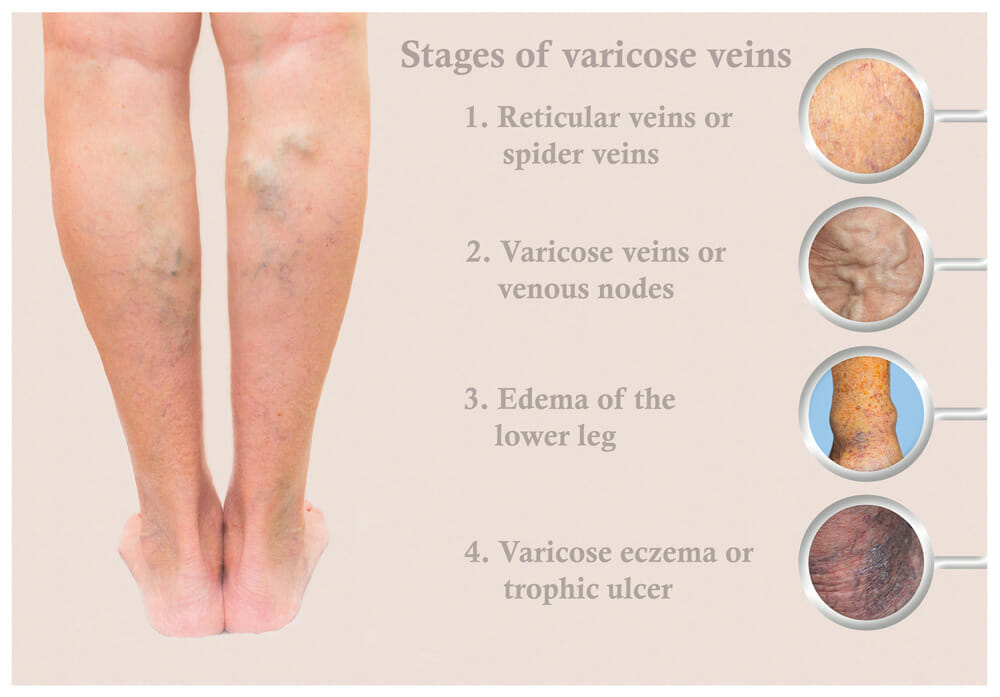Varicose veins affect 1 in 3 Australians. They are a common vein disorder with varying levels of severity. Many people have heard of spider veins, the smaller, red-coloured lines that tend to appear on the backs of the thigh, neck and face. But when we tell new patients at The Vein Institute that the unsightly blue line on their leg or thigh is a reticular vein, this information tends to be received with quizzical looks. This article explains what are reticular veins, how they differ from varicose veins, and best treatment methods.
If you’re unsure if you have spider veins or varicose veins, try our vein self-assessment tool.
How do vein disorders develop?
Vein disorders such as spider veins, varicose veins and reticular veins often originate due to a condition called Chronic Vascular Insufficiency (CVI). When CVI has developed, your vein valves are no longer functioning properly. Weak or faulty valves are unable to push oxygenated blood back to the heart and instead, the blood collects in the vein.
Other than CVI, other causes include:
- Genetics: when it comes to varicose veins, this is the most important factor in determining if they may develop. If your father has varicose veins the risk of inheritance is 30%, while if your mother has varicose veins the risk goes up to 40%.
- Standing or sitting for long periods of time: there are some studies suggesting that professions involving prolonged standing increase your risk of developing vein disorders.
- Gender: statistically, women are at a greater risk of developing a vein disorder than men, this is due to a number of physiological and hormonal influences.
- Age plays a role in weakening vein valves
- Infection in the vein
- Blockage in the vein
- Pregnancy
- Obesity
- Trauma to the leg area
Read more: Varicose Vein Causes.
What are reticular veins?
Smaller than varicose veins – usually no more than 2mm in size – reticular veins also do not protrude above the skin the way that varicose veins do. Due to being filled with deoxygenated blood, they appear blue or purple in colour. Reticular veins are most commonly found on the inner thigh, back of the knee or on the legs and ankles. They may not be quite as noticeable as the larger varicose veins, but their appearance nonetheless deters many people from wearing shorts, bathing suits, skirts or other clothing that reveals areas of the skin where they are visible.
Reticular veins can also produce symptoms such as pain and discomfort in the areas surrounding them. More importantly, they can serve as “feeder veins” for clumps of spider veins, serving as the source of excess blood that fills them.
How to treat reticular veins?
Fortunately, removal of reticular veins is now almost as much of a routine procedure as the removal of varicose veins. An added bonus to removing reticular veins can often help to eliminate spider veins as well.
Reticular veins can be effectively treated using ultrasound-guided sclerotherapy, during which the physician inserts a tiny catheter into the vein and then injects a chemical irritant – either a liquid or a foam – that makes the walls of the vein stick to each other, causing the entire vein to collapse. Reticular veins can also be treated using a laser applied to the surface of the skin. Lasers emit a specific frequency of light that heats up and damages the vein without injuring nearby tissues.
So if you hadn’t heard of reticular veins before, now you know all about them. Like varicose veins and spider veins, they are just one more obstacle that prevents millions of people from enjoying healthy, attractive legs. And fortunately, like varicose veins and spider veins, you don’t have to “live with them” any more.
If you’re looking for non-surgical options to relieve the symptoms of reticular veins, try Bauerfeind’s compression socks.
Seek expert advice
The doctors at The Vein Institute specialise in varicose vein treatment. We offer patients a comprehensive treatment program to treat varicose veins, with non-surgical laser treatment techniques. The benefits of laser treatment to patients are;
- Walk-in walk-out treatment
- 98% success rate
- Extremely effective
- Can be performed at a clinic (no hospitalisation)
- No general anaesthetic
- Medicare rebates apply
- No downtime or time away from work
Call us on 0420 102 637, or fill out our booking request form.



